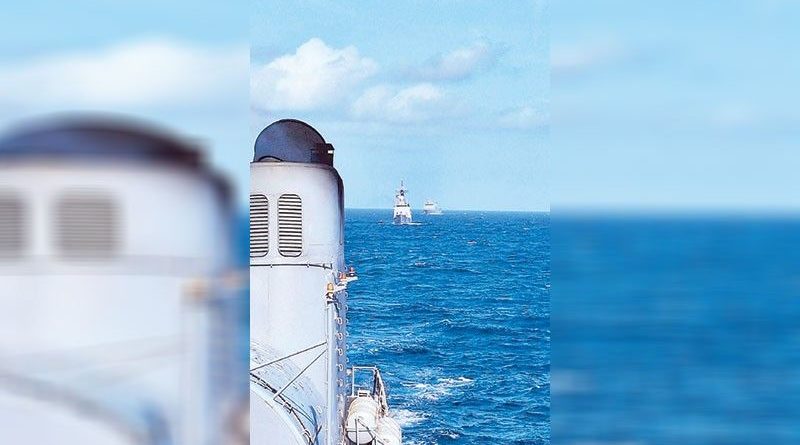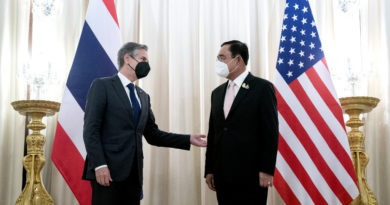HEADLINE-ASIA GEOPOLITICS | China, US hold rival SCS drills

BEIJING – Chinese and US warships were in the South China Sea yesterday, conducting rival exercises in the disputed waters amid heightened tensions involving US ally the Philippines.
Beijing’s People’s Liberation Army Southern Theater Command a day before said a two-day deployment of its navy and air force, scheduled to end today, was carrying out “routine patrols” in the sea.
It did not mention where exactly the patrols took place or give specific details of the goals of the exercises. They took place as the United States said an aircraft carrier strike group led by the USS Carl Vinson was conducting two days of drills with the Philippine Navy.
Beijing claims almost the entire South China Sea and has ignored an international tribunal ruling that its assertions have no legal basis. It deploys boats to patrol the busy waterway and has built artificial islands that it has militarized to reinforce its claims. And while China typically uses its coast guard to enforce its claims in the area, military exercises are not uncommon, with Beijing’s navy conducting “routine” drills in late November.
But this week’s drills follow a month of tense standoff between China and the Philippines in Ayungin Shoal that saw a collision between vessels from the two countries and Chinese ships blasting water cannons at Philippine boats.
One expert told AFP that Beijing was seeking to turn the South China Sea “into a Chinese-controlled waterway and a strategic chokepoint for other countries.”
“The South China Sea is becoming… a key defensive zone for China,” Michael Raska, assistant professor and military expert at Singapore’s Nanyang Technological University, said.
Beijing is also using the area to test “reconnaissance and surveillance,” he said, deepening its ability to “project presence and influence in the sea.”
China this week insisted the Philippines was to blame for the spike in tensions, with the foreign ministry saying Manila had “reneged on its words, changed its policy, infringed on China’s sovereignty and made provocations again and again and triggered complex situations.”
Ministry spokeswoman Mao Ning told a regular press conference on Dec. 29 that “China will take resolute measures against any violation of our sovereignty and provocation, and firmly safeguard our territorial sovereignty and maritime rights and interests.”
This week’s drills also follow the appointment of Dong Jun – a former navy chief and deputy commander of the Southern Theater Command – as Beijing’s defense minister.
Sheena Chestnut Greitens, an expert in Chinese politics, said Dong’s background in “important areas of military tension” and as a naval official may have played a role in his promotion. ”
She said Dong “has operational experience and background in the challenges presented by Taiwan, the South China Sea and the East China Sea.”
In Manila, Armed Forces of the Philippines (AFP) public affairs office chief Col. Xerxes Trinidad said at least two Chinese naval vessels shadowed Philippine and US ships conducting joint drills under the 2nd Maritime Cooperation Activity (MCA) in the West Philippine Sea yesterday.
“The shadowing happened during the activity and I think as of now they are still shadowing, they’re not leaving our trail nor have stopped following our vessels,” Trinidad told reporters. But he stressed everything “went well” during the MCA, which ended yesterday. The previous MCA was held in November.
“As long they do not interfere or do dangerous maneuvers against our vessels, then we will be proceeding as planned and I think we’ve been doing well,” he said, referring to the Chinese vessels.
Coincidence
Trinidad said that while the holding of the 2nd MCA may have merely coincided with China’s own patrols, “we want to emphasize, that the MCA is basically well within our EEZ.”
“So based on our conduct of exercises and based on international law and we hope that all other countries will be respecting the exercise of our sovereignty and our rights for the conduct of said activities well within our exclusive economic zone,” he stressed.
He revealed that similar joint activities with the US and other partner countries would be held this year as part of promoting capability development and interoperability among participants.
For the latest MCA, the AFP said the Philippine Navy utilized four of its vessels as well as a Search and Rescue/multi-role helicopter, and an anti-submarine warfare capable helicopter.
The US, for its part, deployed the Carl Vinson of the Carrier Strike Group 1, as well as a cruiser, two destroyers and multiple combat aircraft.
AFP chief Gen. Romeo Brawner Jr. said the 2nd MCA “marks a significant leap in our alliance and interoperability with the United States.”
“It also demonstrates our progress in defense capabilities and development as a world-class armed force, as we carry out our mandate to protect the people and the state,” he added.
“Our alliance is stronger than ever, sending a message to the world. We are advancing a rules-based international order and a free and open Indo-Pacific region in the face of regional challenges,” Brawner said. – AFP


 Memento Maxima Digital Marketing
Memento Maxima Digital Marketing







